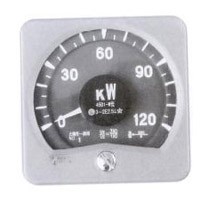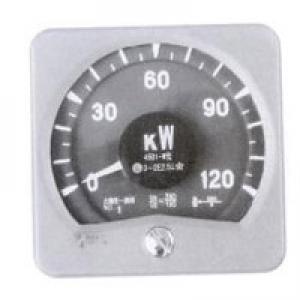Description
Power meter 63L10-W also called a wattmeter, is an instrument for measuring electrical power. Electric power includes active power, reactive power, and apparent power. Unless otherwise specified, a power meter generally refers to a meter that measures active power.
Power meters can be divided into: DC power meters, power frequency power meters, variable frequency power meters, RF power meters and microwave power meters. Because DC power is equal to the simple product of voltage and current, in actual measurement, voltmeters and ammeters are generally used instead. Power frequency power meters are commonly used power meters, and power meters are often referred to as power frequency power meters. Frequency conversion power meter is the product of the rapid development of frequency conversion speed regulation technology in the 21st century. The measurement object is the variable frequency power, which refers to the AC power used to transmit power and meet one of the following conditions:
1. The signal spectrum contains only one frequency component, and the frequency is not limited to the power frequency AC signal.
2. The signal spectrum contains electrical signals of two or more frequency components of interest.
Frequency conversion power includes voltage, current, and active power, reactive power, apparent power, active energy, and reactive energy derived from voltage and current.
In addition to the PWM wave output by the inverter, the current waveform input by the inverter rectified by the diode, the voltage waveform output by the DC chopper, and the input current waveform of the transformer without load, all contain large harmonics. Power waveform and related spectrum.
Due to the complex frequency component of the frequency conversion power, the measurement of the frequency conversion power meter generally includes the fundamental active power (referred to as fundamental power), harmonic active power (referred to as harmonic power), total active power, etc., compared to the power frequency power meter It has more functions and more complicated technology. It is generally called a variable frequency power analyzer or a broadband power analyzer. Some high-precision power analyzers are also suitable for variable frequency power measurement.
The variable frequency power analyzer can be used as a power frequency power analyzer. In addition, it generally needs to meet the following requirements:
1. Meet the necessary bandwidth requirements, and the sampling frequency should be higher than twice the instrument bandwidth.
2. It is required that the analyzer can meet certain requirements within a wide frequency range.
3. With the Fourier transform function, the fundamental and harmonics of the signal can be separated.
RF or microwave power meters are classified according to how they are connected in the test system
There are two types of terminal and through. The terminal power meter uses the power meter probe as the terminal load of the test system. The power meter absorbs all the power to be measured, and the power indicator directly reads the power value. Pass-through power meters use a certain coupling device, such as a directional coupler, a coupling ring, a probe, etc. to couple a portion of the power from the transmitted power at a certain ratio and send it to the power meter for measurement. The total power transmitted is equal to the power meter's indicated value Multiply by the scale factor.
Classification of RF or microwave power meters by measurement principle
Thermistor type power meter uses thermal resistance as the power sensing element. The temperature coefficient of the thermal resistance value is large. The power of the measured signal is absorbed by the thermal resistance to generate heat, which causes its own temperature to rise, and the resistance value changes significantly. The change in resistance value is measured using a resistance bridge to display the power value.
Thermocouple type power meter The thermocouple junction in a thermocouple type power meter directly absorbs high-frequency signal power, the junction temperature rises, and a temperature difference potential is generated. The magnitude of the potential is proportional to the absorbed high-frequency power value.
Calorimetric power meter A typical thermal effect power meter uses a heat-insulated load to absorb high-frequency signal power to increase the temperature of the load, and then uses a thermocouple element to measure the temperature change of the load, and calculates the high-frequency power value based on the heat generated.
The crystal detector power meter crystal diode detector converts high frequency signals into low frequency or direct current signals. Select the working point appropriately so that the amplitude of the output signal of the detector is proportional to the power of the high-frequency signal.
1. Uses:
Built-in installation on ships, locomotives, power stations, mines, metallurgy, petrochemicals or other mobile power equipment, measuring the active power under a balanced or unbalanced phase load in a three-phase AC network with a rated operating frequency of 50, 400, 427 Hz .
2. Main technical performance:
Class 2.5, splash proof and vibration resistant.
3. Conditions of use:
Ambient temperature: -25 ~ + 55 ℃, relative temperature: <98% RH
4. Measurement range: see schedule one and two
5. Weight: 2.7kg
Power meters can be divided into: DC power meters, power frequency power meters, variable frequency power meters, RF power meters and microwave power meters. Because DC power is equal to the simple product of voltage and current, in actual measurement, voltmeters and ammeters are generally used instead. Power frequency power meters are commonly used power meters, and power meters are often referred to as power frequency power meters. Frequency conversion power meter is the product of the rapid development of frequency conversion speed regulation technology in the 21st century. The measurement object is the variable frequency power, which refers to the AC power used to transmit power and meet one of the following conditions:
1. The signal spectrum contains only one frequency component, and the frequency is not limited to the power frequency AC signal.
2. The signal spectrum contains electrical signals of two or more frequency components of interest.
Frequency conversion power includes voltage, current, and active power, reactive power, apparent power, active energy, and reactive energy derived from voltage and current.
In addition to the PWM wave output by the inverter, the current waveform input by the inverter rectified by the diode, the voltage waveform output by the DC chopper, and the input current waveform of the transformer without load, all contain large harmonics. Power waveform and related spectrum.
Due to the complex frequency component of the frequency conversion power, the measurement of the frequency conversion power meter generally includes the fundamental active power (referred to as fundamental power), harmonic active power (referred to as harmonic power), total active power, etc., compared to the power frequency power meter It has more functions and more complicated technology. It is generally called a variable frequency power analyzer or a broadband power analyzer. Some high-precision power analyzers are also suitable for variable frequency power measurement.
The variable frequency power analyzer can be used as a power frequency power analyzer. In addition, it generally needs to meet the following requirements:
1. Meet the necessary bandwidth requirements, and the sampling frequency should be higher than twice the instrument bandwidth.
2. It is required that the analyzer can meet certain requirements within a wide frequency range.
3. With the Fourier transform function, the fundamental and harmonics of the signal can be separated.
RF or microwave power meters are classified according to how they are connected in the test system
There are two types of terminal and through. The terminal power meter uses the power meter probe as the terminal load of the test system. The power meter absorbs all the power to be measured, and the power indicator directly reads the power value. Pass-through power meters use a certain coupling device, such as a directional coupler, a coupling ring, a probe, etc. to couple a portion of the power from the transmitted power at a certain ratio and send it to the power meter for measurement. The total power transmitted is equal to the power meter's indicated value Multiply by the scale factor.
Classification of RF or microwave power meters by measurement principle
Thermistor type power meter uses thermal resistance as the power sensing element. The temperature coefficient of the thermal resistance value is large. The power of the measured signal is absorbed by the thermal resistance to generate heat, which causes its own temperature to rise, and the resistance value changes significantly. The change in resistance value is measured using a resistance bridge to display the power value.
Thermocouple type power meter The thermocouple junction in a thermocouple type power meter directly absorbs high-frequency signal power, the junction temperature rises, and a temperature difference potential is generated. The magnitude of the potential is proportional to the absorbed high-frequency power value.
Calorimetric power meter A typical thermal effect power meter uses a heat-insulated load to absorb high-frequency signal power to increase the temperature of the load, and then uses a thermocouple element to measure the temperature change of the load, and calculates the high-frequency power value based on the heat generated.
The crystal detector power meter crystal diode detector converts high frequency signals into low frequency or direct current signals. Select the working point appropriately so that the amplitude of the output signal of the detector is proportional to the power of the high-frequency signal.
1. Uses:
Built-in installation on ships, locomotives, power stations, mines, metallurgy, petrochemicals or other mobile power equipment, measuring the active power under a balanced or unbalanced phase load in a three-phase AC network with a rated operating frequency of 50, 400, 427 Hz .
2. Main technical performance:
Class 2.5, splash proof and vibration resistant.
3. Conditions of use:
Ambient temperature: -25 ~ + 55 ℃, relative temperature: <98% RH
4. Measurement range: see schedule one and two
5. Weight: 2.7kg



